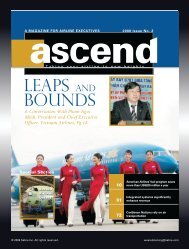the globAl AdvocAte - Sabre Airline Solutions
the globAl AdvocAte - Sabre Airline Solutions
the globAl AdvocAte - Sabre Airline Solutions
You also want an ePaper? Increase the reach of your titles
YUMPU automatically turns print PDFs into web optimized ePapers that Google loves.
A MAGAZINE FOR AIRLINE EXECUTIVES<br />
2006 Issue No. 2<br />
t a k i n g y o u r a i r l i n e t o n e w h e i g h t s<br />
<strong>the</strong> <strong>globAl</strong><br />
<strong>AdvocAte</strong><br />
A Conversation With . . .<br />
Giovanni Bisignani<br />
director general and CEO<br />
International Air Transport Association<br />
g overnment regulations<br />
affect globalization<br />
l atin American carriers<br />
grow regionally<br />
page 38<br />
AirAsia overcomes challenges<br />
to its t hai-based subsidiary<br />
© 2009 <strong>Sabre</strong> Inc. All rights reserved. wearelistening@sabre.com<br />
6<br />
42<br />
50<br />
I N S I D E
Livin’ La Vida Buena
By Lynne Clark | Ascend Staff<br />
M<br />
any airlines north of Mexico may<br />
still be struggling, but strong signs<br />
of recovery, growth and optimism<br />
are visible in Latin America’s previously stagnant<br />
airline industry. Alliances, investments,<br />
new strategies and start-up airlines are showing<br />
a confidence in <strong>the</strong> market that has not<br />
been seen for some time.<br />
The airline industry in Latin American is<br />
one of <strong>the</strong> fastest growing in <strong>the</strong> world with<br />
companies in Brazil, Mexico and Colombia luring<br />
scores of passengers off buses and onto<br />
planes. Growth has largely been triggered<br />
by improvements in <strong>the</strong> region’s economy<br />
and rising per capita income. The number of<br />
passengers in <strong>the</strong> region rose to 76 million in<br />
2005, up 14.4 percent from 2004, according<br />
to figures from Aital, a Miami, Florida-based<br />
industry association grouping of 29 airlines in<br />
Latin America. But while <strong>the</strong> number of passengers<br />
is rising, <strong>the</strong> number of available seats<br />
in Latin America expanded only 8.1 percent<br />
over <strong>the</strong> same period.<br />
The aviation market in South America<br />
can best be described as turbulent: carriers<br />
recovering from <strong>the</strong> economic crash of 2001<br />
still face staggering challenges ranging from<br />
political unrest, shaky local economies and<br />
fluctuating exchange rates to high fees and<br />
taxes, and restrictive legislation.<br />
Despite <strong>the</strong>se challenges, several Latin<br />
American airlines made headlines in recent<br />
months with announcements of new alliances,<br />
fleet acquisitions and cross-border flights signaling<br />
an optimistic future for <strong>the</strong> region’s<br />
emerging airline industry.<br />
profile<br />
TACA Reaches out<br />
Some of <strong>the</strong> biggest news came<br />
in June when United <strong>Airline</strong>s and TACA,<br />
a leading commercial aviation consortium<br />
in Latin America, began a codeshare agreement.<br />
The partnership opens 18 new Central<br />
and South America destinations to United<br />
customers and gives TACA customers unprecedented<br />
access to 192 cities worldwide.<br />
TACA serves 35 cities in 19 countries in<br />
<strong>the</strong> Americas, with hub operations in San<br />
Salvador, El Salvador; San Jose, Costa Rica;<br />
and Lima, Peru.<br />
TOP LATIN AMERICAN CARRIERS<br />
TACA, TAM, LAN, GOL AND COPA<br />
ARE CHANGING THE REGION’S<br />
AIRLINE INDUSTRY THROUGH<br />
INITIATIVES THAT ARE LURING<br />
PASSENGERS FROM BUSES<br />
TO AIRPLANES.<br />
Photo courtesy of TACA<br />
Photo courtesy of United <strong>Airline</strong>s<br />
Earlier this year, TACA and United <strong>Airline</strong>s implemented a codeshare agreement, offering<br />
United customers access to 18 new destinations in Central and South America and giving<br />
TACA customers access to 192 cities worldwide.<br />
“Partnering with such a prominent,<br />
high-quality Latin American airline group as<br />
TACA both streng<strong>the</strong>ns <strong>the</strong> value of our<br />
service and supports our ability to grow internationally,”<br />
said Mike Whitaker, United <strong>Airline</strong>s’<br />
vice president-alliances, international and<br />
regulatory affairs. “Our agreement with TACA<br />
enables us to significantly and strategically<br />
increase <strong>the</strong> depth and breadth of our service<br />
into Central America for our customers.”<br />
Roberto Kriete, TACA’s president of<br />
<strong>the</strong> board and chief executive officer, said,<br />
“Complementary route networks, shared<br />
ascend<br />
43
Photo by Carlos Yamil Ramos/MyAviation.net<br />
Photo by EDINEY/MyAviation.net<br />
Photo by Javier Guerrero/AirTeamImages.net<br />
Photo by Javier Guerrero/AirTeamImages.net<br />
44<br />
ascend<br />
profile<br />
Panama-based Copa <strong>Airline</strong>s and Chile-based LAN have become two of <strong>the</strong> more successful<br />
Latin American carriers. Copa increased its fleet by three aircraft, enabling <strong>the</strong> airline to<br />
add service to Trinidad and Tobago, Brazil, <strong>the</strong> Dominican Republic, Uruguay, and Honduras.<br />
LAN will introduce long-haul service on Boeing 767-300 aircraft to North and South American<br />
destinations.<br />
Brazilian-based TAM and GOL plan to expand to neighboring countries. In July, GOL<br />
launched two new flights to Argentina, and <strong>the</strong> airline plans to launch a low-cost carrier<br />
in Mexico. TAM recently introduced seven new flights, including routes to Paraguay<br />
and Argentina.<br />
commitment to superior customer service<br />
and experience in <strong>the</strong> industry that dates<br />
back to <strong>the</strong> beginning of <strong>the</strong> century make<br />
TACA and United natural partners in <strong>the</strong>ir<br />
continuous efforts to improve <strong>the</strong> customer<br />
travel experience. This agreement’s forward-<br />
looking approach yields strategic implications<br />
that will enable our users to enjoy a<br />
worldwide connection and combined frequent<br />
flyer benefits.”<br />
Copa <strong>Airline</strong>s Expands<br />
Also in June, Copa <strong>Airline</strong>s, a subsidiary<br />
of Copa Holdings, S.A., expanded its fleet with<br />
<strong>the</strong> arrival of three new aircraft, two Embraer<br />
190ARs and one Boeing 737-700 NG, bringing<br />
<strong>the</strong> total number of aircraft in <strong>the</strong> airline’s fleet<br />
to 27. The expanded fleet will accommodate<br />
Copa’s route expansion later this year to<br />
Trinidad and Tobago, Brazil, <strong>the</strong> Dominican<br />
Republic, Uruguay, and Honduras.<br />
“These new routes are part of Copa<br />
<strong>Airline</strong>s’ regional expansion and consolidation<br />
plan, which provides our customers a greater<br />
number of travel options and convenient connections<br />
through our ‘Hub of <strong>the</strong> Americas’<br />
in Panama,” said Jorge Garcia, commercial<br />
vice president, Copa <strong>Airline</strong>s. “Our new flights<br />
contribute to <strong>the</strong> growth of commerce and<br />
tourism in <strong>the</strong>se important cities.”<br />
Copa <strong>Airline</strong>s is one of <strong>the</strong> leading passenger<br />
airlines in Latin America. Operating<br />
from its strategic location in <strong>the</strong> Republic of<br />
Panama, Copa offers more than 90 daily scheduled<br />
flights to 30 destinations in 20 countries<br />
in North, Central and South America and <strong>the</strong><br />
Caribbean. In addition, Copa provides passengers<br />
with access to flights to more than 120<br />
o<strong>the</strong>r international destinations through codeshare<br />
agreements with Continental <strong>Airline</strong>s<br />
and o<strong>the</strong>r airlines.<br />
TAM and GOL Cross Borders<br />
In July, Brazilian-based airlines TAM<br />
Linhas Aéreas and young start-up GOL Linhas<br />
Aéreas Inteligentes both announced cross-<br />
border expansion plans to neighboring countries.<br />
TAM announced seven new flights,<br />
including two international routes, one to<br />
Asunción, <strong>the</strong> capital of Paraguay, and ano<strong>the</strong>r<br />
to Buenos Aires, <strong>the</strong> capital of Argentina. The<br />
announcement came less than a week after<br />
TAM signed a memorandum of understanding<br />
to buy 37 airplanes from Airbus.<br />
Toward <strong>the</strong> end of 2005, TAM, Brazil’s<br />
leading domestic carrier, controlled <strong>the</strong> market<br />
with a 44 percent share, according to <strong>the</strong> country’s<br />
civil aviation authority, <strong>the</strong> Departamento<br />
de Aviação Civil. TAM flies from São Paulo to<br />
major points within Brazil, neighboring countries,<br />
France and <strong>the</strong> United States. Recently,<br />
<strong>the</strong> airline has faced stiff competition from<br />
GOL but remains focused on differentiating<br />
itself by appealing to customers with its high<br />
levels of service (<strong>the</strong> red carpet is rolled out
for boarding passengers) and direct flights to a<br />
large number of destinations.<br />
South America’s most profitable carrier,<br />
GOL, announced two new flights to Argentina<br />
in July and continues to make news in Mexico<br />
as it nears <strong>the</strong> launch of a yet-to-be-named<br />
low-cost carrier.<br />
Since its launch in 2001, analysts agree<br />
that GOL has achieved more in five years<br />
than most companies do in decades. The<br />
company’s share price has more than doubled<br />
since <strong>the</strong> company went public in June 2004.<br />
It has surpassed most of Brazil’s o<strong>the</strong>r moreestablished<br />
air carriers in terms of size and<br />
performance and is now Brazil’s second-largest<br />
domestic carrier, transporting more than<br />
1 million passengers per month, mostly business<br />
customers.<br />
According to GOL, Mexico is Latin<br />
America’s second-largest airline market after<br />
Brazil, transporting 30 million passengers per<br />
year on domestic and international routes.<br />
The Mexican market seems ripe for<br />
GOL’s low-cost strategy aimed at customers<br />
who normally travel by bus. Mexican airlines<br />
transport roughly 18 million passengers a year<br />
on domestic routes, while an estimated 2.5<br />
billion trips are made by highway, according to<br />
<strong>the</strong> government-run airline holding company<br />
46<br />
Number of airports implementing<br />
International Air Transport<br />
Association common self-serve<br />
kiosks as part of IATA’s Simplifying<br />
<strong>the</strong> Business initiative.<br />
profile<br />
LAN Peru, with a hub in Lima, brings thousands of travelers each year to <strong>the</strong> city and its many attractions such as <strong>the</strong> ca<strong>the</strong>dral<br />
in <strong>the</strong> Plaza de Amas.<br />
+count it up<br />
Cintra S.A. The potential market for domestic<br />
air travel in Mexico is 50 million passengers a<br />
year, according to Cintra.<br />
GOL has partnered with Mexican<br />
investment group Inversiones y Tecnicas<br />
Aeroportuarias S.A. and is working with authorities<br />
to begin flights in <strong>the</strong> near future.<br />
LAN Goes Premium<br />
Chilean-based LAN announced in June<br />
that it was joining o<strong>the</strong>r major world carriers<br />
in eliminating first class by focusing on<br />
its “premium business” to be introduced<br />
on Boeing 767-300 long-haul flights between<br />
North and South America during <strong>the</strong> second<br />
half of 2006.<br />
LAN <strong>Airline</strong>s is one of <strong>the</strong> leading airlines<br />
in Latin America and is part of one of <strong>the</strong><br />
region’s most successful airline service alliances<br />
that includes LAN Express, LAN Peru,<br />
LAN Ecuador, LAN Argentina and LAN Cargo.<br />
Through its own operations and codeshare<br />
arrangements, LAN serves 15 destinations<br />
in Chile, 11 destinations in Peru, nine<br />
destinations in Argentina, two in Ecuador, 20<br />
in o<strong>the</strong>r Latin American countries, 25 in North<br />
America, 10 in Europe and four in <strong>the</strong> South<br />
Pacific. Currently, LAN operates 67 passenger<br />
aircraft and nine dedicated freighters.<br />
225+ billion<br />
Amount in U.S. dollars <strong>the</strong> International<br />
Air Transport Association’s financial<br />
systems process annually.<br />
LAN <strong>Airline</strong>s is a member of <strong>the</strong> oneworld<br />
alliance. It has bilateral commercial<br />
agreements with oneworld partners American<br />
<strong>Airline</strong>s, British Airways, Iberia <strong>Airline</strong>s and<br />
Qantas Airways and also with Alaska <strong>Airline</strong>s,<br />
AeroMexico, Mexicana and TAM. One of <strong>the</strong><br />
biggest airlines in Latin America, it posted<br />
profits for <strong>the</strong> fourth quarter of US$47.6 million<br />
compared with US$35.2 million for <strong>the</strong> same<br />
period <strong>the</strong> previous year.<br />
Although <strong>the</strong> airline has not made an<br />
official statement, tourism and travel magazines<br />
as well as Web sites indicate LAN is<br />
considering entering <strong>the</strong> Brazilian market possibly<br />
in 2008.<br />
While speaking to <strong>the</strong> Aviation Club of<br />
Great Britain in 1998, former United <strong>Airline</strong>s<br />
President Jim Goodwin said, “In <strong>the</strong> world of<br />
Latin American aviation, nothing works as well<br />
as a good marriage. As <strong>the</strong> skies across <strong>the</strong><br />
region open to competition from global carriers,<br />
alliances may be <strong>the</strong> determining factor in<br />
<strong>the</strong> success or failure of <strong>the</strong> region’s domestic<br />
airlines.” Judging by <strong>the</strong> headlines, <strong>the</strong> honeymoon<br />
is just beginning for a growing number<br />
of Latin American carriers. a<br />
5.7<br />
Lynne Clark can be contacted at<br />
wearelistening@sabre.com.<br />
Percentage of <strong>the</strong> world’s aircraft<br />
fleet that will be replaced during <strong>the</strong><br />
next two years, a decrease from <strong>the</strong><br />
7 percent rates of previous peaks.<br />
ascend<br />
<strong>Sabre</strong> <strong>Airline</strong> <strong>Solutions</strong> archive 45
















